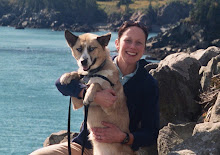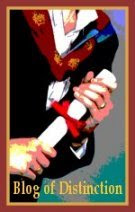
Low: 58° FGrowing up, I had a “best friend” named Cathy. I put this term in scare quotes deliberately: while our moms were convinced that Cathy and I were destined to be lifelong confidants, the two of us were often less certain of our BFF status. Sometimes, we got along famously. Other times, we pulled each other’s hair and chased one another around the house with kitchen implements (I still maintain this is because Cathy would never share her toys with me. I suspect she would disagree).
High: 82° F
Conditions: Humid with a chance of thunderstorms.
Cathy was very pretty and very, very proper (except for when she was chasing me around the living room with a potato masher). She always wore her hair in pigtails with pink ribbons and she knew about lip-gloss years before I had anything other than a milk mustache for adornment. I, on the other hand, wore tube socks with sandals and preferred pillow-time snarls to anything more coifed. Cathy played Barbie and went to gymnastics classes; I built go-carts and was the worst soccer player on an otherwise all-boy team. These may be just a few reasons why our friendship was a little hot and cold.
Meet Ari’s Cathy:
 This is Sylvie, the gorgeous rescued pharaoh hound. Sylvie’s human housemates are good friends of ours, so the two get to spend a fair amount of time together. Sometimes, they are thick as thieves. Other times, they’d just as soon bite off one another’s snout than share a rawhide.
This is Sylvie, the gorgeous rescued pharaoh hound. Sylvie’s human housemates are good friends of ours, so the two get to spend a fair amount of time together. Sometimes, they are thick as thieves. Other times, they’d just as soon bite off one another’s snout than share a rawhide.Still, like doting parents, Sylvie’s human Julie and I believe in the prospect of their friendship.
That’s why we took the two dogs to Moose Point State Park this morning for a grand day out. Moose Point is a lovely bit of land settled by Scotch-Irish immigrants during the late 18th century. It was claimed by the British during the War of 1812. Once the colonists got it back, nobody was all that keen on living where Red Coats had just been, so the land returned to forest and, eventually, a state park.
 It’s a lovely patch of land on the edge of a bio-rich estuary, where eagles and osprey regularly come to feed. It’s also a favorite place of both Ari and Sylvie’s, so Julie and I were certain it was the perfect place for an outing.
It’s a lovely patch of land on the edge of a bio-rich estuary, where eagles and osprey regularly come to feed. It’s also a favorite place of both Ari and Sylvie’s, so Julie and I were certain it was the perfect place for an outing. That, of course, assumed that we could get the dogs out. We had planned to take Julie’s larger SUV so that the dogs would have more personal space. But Ari wasn’t about to get in any vehicle claimed by Sylvie. We tried putting Sylvie in the very back and Ari in the very front, but the caninaturalist wasn’t about to have any of it. After a good 10 minutes of trying, we gave up and opted for my diminutive Honda. Ari was okay with this, provided she got to sit on the top of the hatchback, where she could lord over Sylvie. Miraculously, Sylvie was fine with her bossy friend’s demands.
That, of course, assumed that we could get the dogs out. We had planned to take Julie’s larger SUV so that the dogs would have more personal space. But Ari wasn’t about to get in any vehicle claimed by Sylvie. We tried putting Sylvie in the very back and Ari in the very front, but the caninaturalist wasn’t about to have any of it. After a good 10 minutes of trying, we gave up and opted for my diminutive Honda. Ari was okay with this, provided she got to sit on the top of the hatchback, where she could lord over Sylvie. Miraculously, Sylvie was fine with her bossy friend’s demands.Once we arrived at the park, there was a minor altercation when a ranger offered the two dogs two biscuits (both pups agreed this was absolutely the wrong ratio of canine to treat) and when I tried to offer Sylvie some of Ari's water (which the caninaturalist believes is a highly limited resource, all drinking fountains to the contrary). It's a good thing neither one of them had access to rolling pins of the opposable thumbs needed to use one as a weapon.

The caninaturalists gave it a dutiful glance or two, but neither experienced the reverence shared by their human companions.
 Like any good adolescents, they were far more interested in what their peers had been up to around the trail. Would we have liked a little more transcendent awe from both of them? Maybe. But if good gossip prevents a blood letting, we're willing to make a few concessions now and again.
Like any good adolescents, they were far more interested in what their peers had been up to around the trail. Would we have liked a little more transcendent awe from both of them? Maybe. But if good gossip prevents a blood letting, we're willing to make a few concessions now and again.



 A pretty good ID, I think. But what in the world do you make of this photo?
A pretty good ID, I think. But what in the world do you make of this photo? Is it even a butterfly? I doubt anyone could tell for sure. I'm not certain, and I'm the one who took the lousy picture. From a long way away. With a mediocre point-and-shoot camera.
Is it even a butterfly? I doubt anyone could tell for sure. I'm not certain, and I'm the one who took the lousy picture. From a long way away. With a mediocre point-and-shoot camera. And when we came upon these two clowns, you can forget about our new career as lepidopterists, not when good caninology is at least as good (and probably ultimately more rewarding).
And when we came upon these two clowns, you can forget about our new career as lepidopterists, not when good caninology is at least as good (and probably ultimately more rewarding). We were flummoxed.
We were flummoxed. 

 What is it? I have absolutely no idea. I doubt the scientists will either. As for the caninaturalist, she’s too busy burying my net in some hidden location in the backyard to care.
What is it? I have absolutely no idea. I doubt the scientists will either. As for the caninaturalist, she’s too busy burying my net in some hidden location in the backyard to care.



 On Thursday, they'll undergo their first sea-test under full sail. In the meantime, the crews took all three out for a few quick turns around the harbor before docking for the night.
On Thursday, they'll undergo their first sea-test under full sail. In the meantime, the crews took all three out for a few quick turns around the harbor before docking for the night.
 Ari wasn't nearly as excited as we were to hear about the sea-test, but she was plenty thrilled when the humans decided to celebrate the day with ice cream, which meant that she got more than her fair share of ooey-gooey cone.
Ari wasn't nearly as excited as we were to hear about the sea-test, but she was plenty thrilled when the humans decided to celebrate the day with ice cream, which meant that she got more than her fair share of ooey-gooey cone.



 It’s hard for a caninaturalist not to love a plant with a name like lupine (especially when she wears a collar by the same name). We’ve read a few different accounts of how this flower came by its moniker: one source says that it’s because the individual flowers look like dog teeth. Another says its because their silvery appearance glows in the moonlight (which may be why there is a werewolf named Lupin in Harry Potter). My favorite explanation, though, comes from a book called Wildflowers Worth Knowing by Neltje Blanchan. There, Blanchan writes:
It’s hard for a caninaturalist not to love a plant with a name like lupine (especially when she wears a collar by the same name). We’ve read a few different accounts of how this flower came by its moniker: one source says that it’s because the individual flowers look like dog teeth. Another says its because their silvery appearance glows in the moonlight (which may be why there is a werewolf named Lupin in Harry Potter). My favorite explanation, though, comes from a book called Wildflowers Worth Knowing by Neltje Blanchan. There, Blanchan writes:



 This is one of the town’s five fire ponds. Dug fifty years ago, It’s still used by our volunteer fire department to refill its tankers after a blaze. Since that doesn’t happen very often, mostly it just serves as a great wildlife refuge in miniature. During the early spring, we can catch the salamanders and peepers here. By autumn, a single blue heron will have moved in for a brief layover before heading further south.
This is one of the town’s five fire ponds. Dug fifty years ago, It’s still used by our volunteer fire department to refill its tankers after a blaze. Since that doesn’t happen very often, mostly it just serves as a great wildlife refuge in miniature. During the early spring, we can catch the salamanders and peepers here. By autumn, a single blue heron will have moved in for a brief layover before heading further south. This time of year, the pond is a great place for Ari to get a slimy, free-range salad before her proper dinner. It’s also wonderful bullfrog and turtle watching, which is what she’s doing here.
This time of year, the pond is a great place for Ari to get a slimy, free-range salad before her proper dinner. It’s also wonderful bullfrog and turtle watching, which is what she’s doing here. When they’re on holiday, we make do with a little mucky wading or swimming: the only things that can possibly compete with frosty blueberries and a cool tile floor on a day like today!
When they’re on holiday, we make do with a little mucky wading or swimming: the only things that can possibly compete with frosty blueberries and a cool tile floor on a day like today!




















